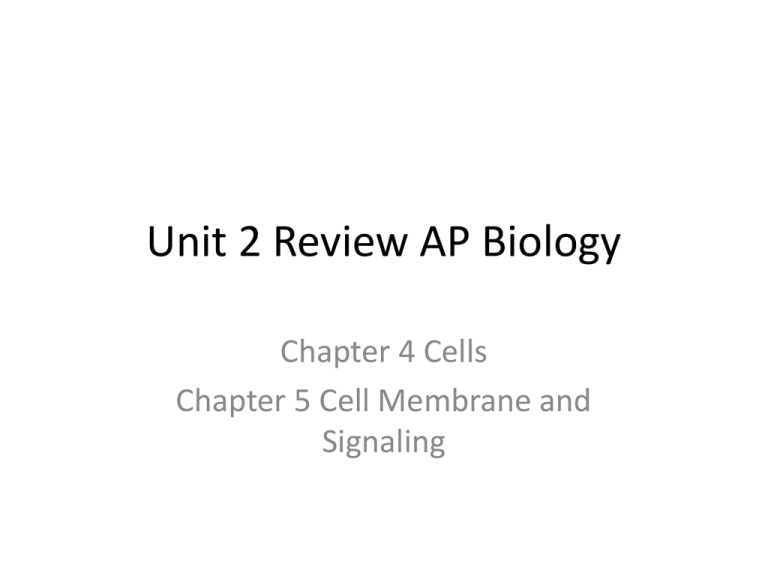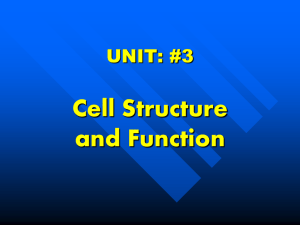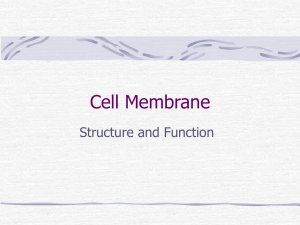File - Biology with Radjewski
advertisement

Unit 2 Review AP Biology Chapter 4 Cells Chapter 5 Cell Membrane and Signaling 1. Calculate surface area to volume ratio 10 um 20 um 100 um Surface Area 600 um2 2400 um2 60,000 um2 Volume 1000 um3 8000 um3 1000000 um3 Surface Area to Volume Ratio 3:5 3:10 3:50 Reduced 0.6 : 1 0.3 : 1 0.06 : 1 Surface Area = 6 X length squared Volume = length x length =x length 2. Which size cell would be the first to get a toxin in the middle? • The smallest cell would be first • Why? • The smallest cell has the greatest surface area relative to its volume. • The toxin would have greater opportunity to enter the cell because of this ratio 3. Explain how prokaryotes carry out enzymatically catalyzed biochemical conversions without organelles? • There are proteins in the cytoplasm moving around. • This motion ensures that reactions are taking place at a rate sufficient for the cell to survive. • There are also enzymes in the cytoplasm to catalyze reactions. 4. Explain whether ribosomes are present only in eukaryotes, only in prokaryotes, or in both. • Both • Ribosomes make proteins and proteins are essential in all living things 5. Describe the structure and function of as many cellular organelles as you can in regard to the synthesis and secretion of protein signals. • RER – proteins are synthesized on the ribosomes and then delivered to Golgi • SER – stores Ca+ that trigger the secretion of proteins that are secreted by cells • Golgi Body – concentrates, packages, sorts and modifies proteins to send them to their destination • Ribosomes – make proteins from amino acids 6. Label the membrane. 7. Explain how the structure of the phospholipid is amphipathic and can form a bilayer that is nonpolar in middle and polar on the outsides • Middle is hydrophobic due to the fatty acids • Outside is hydrophilic due to the phosphate groups. 8. What are the 2 primary factors that influence membrane fluidity? • Lipid composition and temperature 9. Explain how the ink diffused through the gel even though there were no currents. • By diffusion its random and it will go until equilibrium. 10. Describe 2 differences between passive and active transport Passive • Moves materials from high to low • No energy needed Active • Moves materials from low to high • Requires energy • All require proteins 11. Define and provide a description • Isotonic – Equal solute concentrations on each side of membrane – No net movement of water in/out of cell • Hypotonic – Low solute concentration outside the cell – Causes enlargement of cells • Hypertonic – High solute concentrations outside the cell – Causes shrinking of cells 12. Is facilitated diffusion active or passive transport? Explain why. • Passive transport • No energy is required even though there are proteins involved. 13. Explain how cells are involved in the transition from wilted to normal. • Wilted hypertonic resulting in a flaccid appearance • When a wilted plant is watered, water moves in to the shrunken cells, expanding them. Cells become plump again and has turgor pressure. 19. Complete table. Simple Diffusion Osmosis Facilitated Diffusion Active transport Cellular Energy required? No No No Yes Driving force? Concentration Gradient Concentration Gradient Concentration Gradient ATP hydrolysis Membrane protein required? No Yes for some cells, No for others Yes Yes Directional? No No No Yes Specificity? No No Yes Yes 20. Explain the Na+K+ Pump • 3 sodium ions get pumped OUT • 2 potassium ions get pumped IN • Requires 1 ATP – ATP gets broken down into ADP + inorganic phosphate 16. Explain how phagocytosis and pinocytosis are similar and different Similar • Both forms of endocytosis • Both involve the folding of the plasma membrane • Both active transport • Both bring materials into the cell Different • Phagocytosis is bringing in large particles/cells • Pinocytosis is bringing in fluids and dissolved substances 17. Describe each step of cell signaling • Signal – Signal arrives at target. Signal molecule may be a specific molecule or a physical stimulus. • Receptor – Signal molecule fits into the receptor protein and binding occurs • Response – Receptor changes its 3D shape and this initiates a cellular response 18. If a cell had no proteins, will it be able to respond to any environmentally stimuli? Explain • No • Cells must have specific receptors to any environmental stimuli and receptors are always made of protein 19. Why doesn’t caffeine enter the cell? • Caffeine is large • Caffeine is polar (see nitrogens) • It is unlikely to diffuse through the plasma membrane so it likely will bind to a receptor on the surfaces of nerve cells in the brain 20. All cells have • Cytoplasm • Plasma membrane • ribosomes 21. Animals HAVE (and plants don’t) • • • • • • Lysosomes Centrioles Flagella Cilia More rounder shape Smaller and more vacuoles 22. Plants HAVE & animals don’t • • • • Cell wall Chloroplast Square shape Central vacuole 23. Prokaryote vs. Eukaryote Pro • Older • No nucleus (nucleiod) • No organelles • Simpler ribosomes • Bacteria is an example Euk • Younger • Nucleus and nuclear membrane • Organelles • Complex ribosomes • Plants, animals, fungi and protists are examples Exam: • • • • 20 multiple choice – cells (chapter 4) 9 chapter 5 3 cell signalling ch 4 Short Answer – Labeling Chapter 4 – Calculate % change in mass – Calculate SA:V ratio – Calculate solute potential – Calculate standard deviation • 10 point essay











